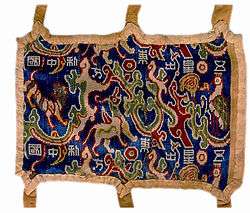"Five stars rise in the East" arm protector

The "Five stars rise in the East" arm protector (“五星出东方”护膊) is a Han and Jin dynasties-era brocade armband embroided with the words "Five stars rise in the east, benefitting China" (Chinese: 五星出東方利中國).[1][2] Another cloth of the same pattern was found later but contain the words "put down South Qiang" (討南羌).[1] In 2002, they were designated one of the cultural relics that forbidden to be exhibited abroad.[3]
Discovery
The pieces were unearthed in October 1995 at the Niya archaeological site in Xinjiang.[2] When the cloth was unearthed, it was found near the elbow waist area of one of the corpse.[1]
Interpretation
The phrase "Five stars rising east benefit China" (五星出東方利中國) resembles a similar phrase found in the Records of the Grand Historian's scroll 27 (五星分天之中,積於東方,中國利). In the ancient times the five stars were represented as Chenxing (辰星), Taibai (太白), Yinghuo (熒惑), Suixing (歲星) and Zhenxing (鎮星). In modern times these are Mercury, Venus, Mars, Jupiter, Saturn respectively. These are also represented by Wu xing with water, metal, earth, fire, wood.[1] Researchers from the Japanese observatory said the next alignment of the five stars to the east will not be until March 21, 2022.[1] The phrase have been used to describe the prophecy of the rise of the People's Republic of China represented by the PRC five star flag.[4] Dong fang (東方) may also mean east or it can also be the surname Dongfang.
The phrase "put down South Qiang" (討南羌) refers to the area that was first mentioned in a sentence in the Western Han Essentials's (西漢會要) scroll 46 in relation to the four ancient commandery. The four are geographically today's Gansu Dunhuang, Jiuquan, Zhangye and Wuwei.[1] Another place referred to maybe the ancient Jingyue kingdom (精絕國).
When the two pieces are combined, it forms the phrase "Five stars rising east benefit China put down South Qiang" (五星出東方利中國討南羌), though the meaning is up for debate.
See also
References
- 1 2 3 4 5 6 Sina.com. "Sina.com." 五星出東方利中國. Retrieved on 2010-06-04.
- 1 2 Big5.china.com.cn. "Big5.china.com.cn." 尼雅“五星出東方利中國”錦是蜀錦. Retrieved on 2010-06-01.
- ↑ Wenbao.net. "Chinese cultural heritage protection official web list." 五星出东方. Retrieved on 2010-06-01.
- ↑ Wenweipo.com. "Wenweipo.com." 它們差點成為國旗. Retrieved on 2010-06-04.